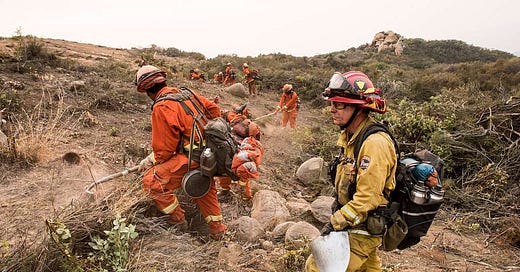Trapped by Climate Chaos: Incarceration, Exploitation, and Environmental Injustice
The OAJ is currently looking for interested students to join our team! If you’ve read our work before (or if this is your first time), and you like what we do, please email OAJ Executive Editor Paulina Campos at openair@brandeis.edu to join the journal.
The piece below is part of our weekly blog post series written by the Open-Air Journal team where we explore issues at Heller, current events, or whatever is presently on our minds.
The climate crisis’s impacts are felt disproportionately by the most vulnerable, yet few groups are as overlooked as incarcerated individuals. Trapped in overcrowded and underfunded facilities, incarcerated people must endure extreme heat, natural disasters, and environmental hazards without adequate protection or the ability to evacuate. Despite this, their labor is often the first to be volunteered when climate disasters strike. As climate chaos intensifies, this system not only subjects incarcerated individuals to worsening environmental conditions but also forces them into dangerous, underpaid, and non-consensual labor to combat the very crises that disproportionately harm them.
When the 13th Amendment was ratified in 1865, slavery was abolished throughout the United States. However, the act included the clarification that slavery may be utilized “as a punishment for crime whereof the party shall have been duly convicted.” This exception allows the government to force incarcerated individuals into labor, a practice that has persisted since the post-Civil War convict leasing system. Today, this rule enables a legal form of slavery where state and private enterprises profit from incarcerated labor while offering minimal wages and few, if any, worker protections. Additionally, racial disparities persist in US prisons, with Black people being largely overrepresented in most jails. Penal labor has become an integral part of the U.S. economy, with incarcerated individuals performing a wide range of tasks for both public and private institutions. From Whole Foods to Walmart, shelves are stocked with goods made by incarcerated individuals. While proponents argue that prison labor provides valuable work experience and rehabilitation, the reality is that it is often coercive, dangerous, and grossly under-compensated. The 13th Amendment clause allows this exploitation to continue largely unchecked, reinforcing economic and racial disparities while maintaining a system that profits from incarceration.
As climate disasters like fires, hurricanes, and flooding become more frequent, those in the penal system are sacrificed as a cheap workforce, despite health and safety risks. Last month, thousands of incarcerated individuals were deployed to protect lives and property from the California wildfires, with their labor making up a third of those on the front lines. While California’s minimum wage is $16.50, these firefighters earn between $0.16 to $0.74 an hour. Upon release, however, many of these former firefighters are barred from obtaining firefighting jobs due to their criminal records.
Beyond firefighting, incarcerated workers are used to clean up hurricane wreckage, remove toxic debris, and perform other forms of climate disaster recovery. These tasks expose them to hazardous conditions and physical injury that can cause lifelong disabilities, further limiting their chances of reintegrating into the workforce. Despite the high risks, incarcerated workers are neither provided with the same labor protections as civilian workers nor allowed to unionize or advocate for fair wages. Their role in disaster response demonstrates the fundamental injustice of prison labor: those most affected by climate change are forced to combat it under deadly conditions, with little recognition or compensation. In addition to the miniscule wages, many states deduct large portions of their earnings to cover court fees, restitution payments, and even the cost of their own imprisonment. As a result, incarcerated workers see only a fraction of their hard-earned compensation.
In 2020, California Governor Gavin Newsom finalized a law that made it easier for incarcerated firefighters to have their records expunged. Some laborers said that the work gave them a valuable skill set that would make them more desirable for employers following their release. In exchange for laying their lives on the line, firefighters can earn a reduced sentence. However, many incarcerated workers have no choice but to participate, facing punishments such as solitary confinement or loss of privileges if they refuse. One person incarcerated in Louisiana stated: “Most of my lockdown came from refusing to be a slave…working in fields of corn, etc. Free people riding horses with guns telling you to pick this, do that, and/or write you up for disciplinary just because he or she can.” The reality is that prison labor is not about rehabilitation—it is about maintaining a system of economic exploitation under the guise of “earning” your way back into society.
Efforts to challenge the 13th Amendment clause have gained momentum in recent years, thanks in part to groups like the ACLU and The Marshall Project. Advocacy organizations such as these continue to push for the removal of the exception clause, arguing that any form of involuntary servitude is a violation of human rights. However, resistance remains strong, as seen in California's failure to pass a measure banning prison labor on the November 2024 ballot. Corporations, government agencies, and private prisons all benefit from the current system and do their best to slow progress.
The climate crisis has intensified the exploitation of incarcerated people who are forced into dangerous, underpaid labor under the 13th Amendment. While prisons are ill-equipped to protect those inside from extreme weather, they are quick to exploit their labor to respond to climate disasters. The continued use of incarcerated workers for climate-related labor, often under conditions that violate basic human rights, exposes the deep intersection of environmental, racial, and economic injustice. To honestly seek justice and rehabilitation, the United States must confront its subservience to the industrial prison complex and the exploitative nature of the labor system. The fight for climate justice must also be a fight for labor and carceral justice—one that acknowledges the humanity and dignity of those forced to work behind bars.
Thanks for reading Open-Air Journal! Subscribe for free to receive new posts and support my work.







